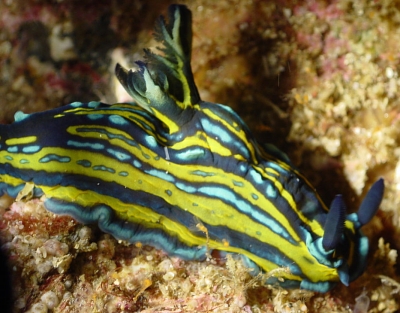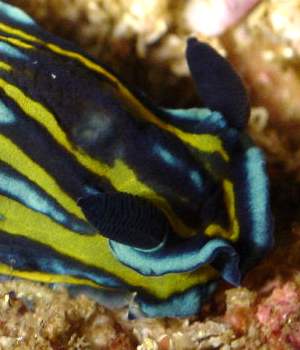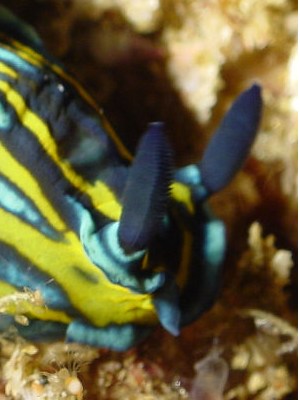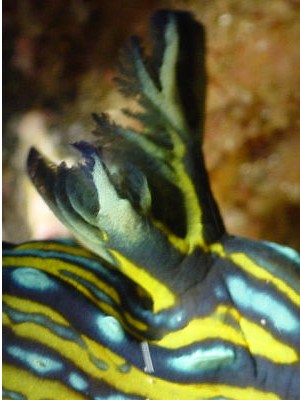
Tambja haidari
Pola, Cervera & Gosliner, 2006
Order: NUDIBRANCHIA
Suborder: DORIDINA
Superfamily: ANADORIDOIDEA
Family: Polyceridae
Subfamily: Nembrothinae
DISTRIBUTION
Known only from Dakar, Senegal.
PHOTO
Gouye teni M'bot, Dakar, Senegal, Eastern Atlantic. Depth: 22 m. Size: 95-100 mm. June 04, 2003. Photos: Marina Poddubetskaia
Tambja haidari sp. nov. is only . This species has dark blue ground colour with yellow bands and sky-blue spots, which become real tubercles along the tail. There are several dorsal and lateral yellow bands running from the head to the end of the tail. Between these bands are short blue bands or spots, which can be raised. The blue spots on the tail are tuberculate. The gills are dark blue while the inner rachis is mostly yellow and the outer rachis, blue. The rhinophores are dark blue and the sheth edged in blue. The oral tentacles, the anterior margin of the head, the anal papilla, the genital pore and the foot are also bordered in blue. Behind the rhinophores there are two distinctive arrow-tip shaped dark blue spots. The internal features are typical of species of the genus, with rachidian teeth that lack denticles and with a prostate slightly differentiated from the rest of the vas deferens. The living animals may reach 52mm in length.
-
Pola, M., Cervera, J. L., and Gosliner, T. M. (2006) Description of two new phanerobranch nembrothid species (Nudibranchia: Polyceridae: Doridacea). Journal of the marine biological Association, U.K. 86: 403-409.
Rudman, W.B., 2006 (July 15) Tambja haidari Pola, Cervera & Gosliner, 2006. [In] Sea Slug Forum. Australian Museum, Sydney. Available from http://www.seaslugforum.net/find/tambhaid
Related messages
Re: Roboastra europaea? from Senegal
July 18, 2003
From: Marina Poddubetskaia

Dear Bill,
Thanks for your comments. The only better photo of the head I have is this one (of the same animal). I hope it would help you.
Cheers,
Marina.
nembro@nembro.info
Note added 15 July 2006: This species has now been named Tambja haidari
Thanks Marina,
Yes it does help. It shows that the dark blue bit I thought might be a large oral tentacle is a fold of the mantle edge. This would suggest your animal is not a species of Roboastra. I suspect its a Tambja, but not a species I am familiar with
Best wishes,
Bill Rudman
Roboastra europaea? from Senegal
July 17, 2003
From: Marina Poddubetskaia

Dear Bill,
I found this mysterious nembrothid near Dakar. It makes me think of Roboastra europaea, but also it seems different from the usual colour forms.
Date: June 04, 2003
Location: Senegal, Eastern Atlantic
Site: Gouye teni M'bot
Depth: 22m
Size: 95-100mm
Photos: Marina Poddubetskaia - Nembro website
Best wishes,
Marina.
nembro@nembro.info


Note added 15 July 2006: This species has now been named Tambja haidari
Thanks Marina,
Have you a photo that shows the head more clearly? I am not if there is a long oral tentacle in front of its right rhinophore [the left one in photo] which would suggest it is a species of Roboastra, or whether its a fold of the mantle edge. I suspect its a species of Tambja but if so I don't recognise it. I am sure Lucas Cervera will be able to help us with an identification.
It is possibly the animal that Pruvot-Fol (1927)identified from the Atlantic coast of Morocco (1927) as Nembrotha diaphana Bergh 1877. Pruvot-Fol's animal was 'yellow-sulphur with grey violet lines' when alive. However it is unlikely that an animal from West Africa could be Bergh's Nembrotha diaphana which is based on a tropical Pacific specimen which lacked any information on its living colour. All we can say from Bergh's anatomical description is that Nembrotha diaphana is a species of Tambja.
• Bergh, L.S.R. (1877) Malacologische Untersuchungen. In: C.G. Semper, Reisen im Archipel der Philippinen, Wissenschaftliche Resultate, 11: 429-494, Pls.54-57.
• Pruvot-Fol,A (1927) Sur quelques mollusques nudibranches de la cote atlantique de Maroc, recoltes principalement par MM. J. Liouville et R. Ph. Dollfus. Bulletin de la Societe des Sciences Naturelles et Physiques du Maroc, 7(13): 39-49. (Pl. 5)
Best wishes
Bill Rudman
